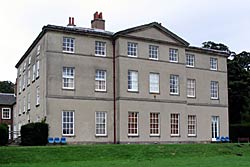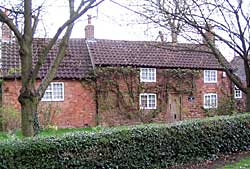Their eldest son, John, is represented by the canopied tomb in the north wall of the chancel. He died in 1501, and his wife Sanchia, daughter of Sir Robert Willoughby, in 1500. The canopy is very like one of the same period in Wollaton Church, and is believed to be by the same mason. The feet are supported by a lion on whose back sit two little figures of bedesmen, or "weepers", with rosaries in their left hands. The roodscreen, a beautiful specimen of Perpendicular work, was erected during John's life-time, probably about 1490. It was saved from destruction during the Civil Wars by being boarded up till the Restoration.
At the west end of the tomb is a small slab in memory of their twin children, James (the only son) and Sanchia. The vast estate of the Strelleys was, therfore, divided among the four remaining daughters, and the manor of Strelley alone passed to John's younger brother Nicholas.
The inscription on the alabaster slab to the north-east of the altar-tomb is now illegible, but it is in memory of John's nephew Nicholas, the next owner of the manor, who died in 1560, having had three wives, four sons and four daughters. The fourth son was known as Henry Strelley of Hempshill, a property of the Strelleys near the now demolished Nuthall Temple, and from him were descended the Strelleys of Oakerthorpe. One of the daughters, Alice, married the second Byron owner of Newstead, "Little Sir John with the Great Beard," thereby ending a family feud. They were both buried at Colwick, and their very beautiful tomb is one of those now removed to Newstead.
Members who are interested in the tombs described may like to know that there are rubbings of the brass slabs in the Central Library.
After the division of the estate, the importance of the family gradually declined, and Thoroton remarked: "This Manner hath been the inheritance of Lawyers most of my time and for some space before". For a long time the possession was disputed, and Mrs. Hutchinson, in the Memoirs of her husband, Colonel John Hutchinson, tells how her husband helped young George Strelley to recover part of his property from Colonel Francis Hacker (the regicide), whose father had been Strelley's stepfather and trustee. Eventually another Nicholas Strelley held the lordship, and he, in Thoroton's time, lived in Nottingham "upon some ingenious manufactures in glass, which he spins and orders very commendably".

Strelley Hall was designed by Thomas Gardiner, 1789-92 and incorporates the remains of a medieval tower (photo: A Nicholson, 2005).
About 1678, the manor was bought by Ralph Edge, whose descendants have held it ever since. He created a precedent by being appointed Town Clerk in 1658 before he had been admitted as burgess. He held this office until his death in 1686, and was also Mayor of Nottingham three times - in 1664, 1671 and 1678. The present Hall was built on the site of the old house in the early 1790's, by Thomas Webb Edge.
In the summer of 1801, not many years after the building was completed, this Mr. Edge and his wife were sitting in the park one day, when they noticed something shining in a molehill that was gradually being turned up while they watched. This proved to be a large gold ring, engraved with a female figure in loose, flowing robes, her head surmounted by a halo. Above and below the figure were what appeared to be the words "Seynt Edith", so that the ring has since been known as St. Edith's ring. The lettering suggests the 14th or 15th century, and it is quite possible that the ring was lost by a former member of the Strelley family.
The Central Library has in the Muniment Room a bill made out to Thomas Webb Edge, of Strelley, on March 12th, 1817, for insuring a pipe of madeira wine which was being shipped on board the John, under Captain Popplewell, from Madeira to Jamaica and London. The cost of the insurance was £3/13/6, and the duty 5/3.

Grange Cottage, Strelley (photo: A Nicholson, 2004).
One of the most exciting days in Strelley's history of which we have any record was the occasion of the return of Mr. J.T. Edge and his bride after their marriage in January, 1856. Fyfe, the author of Rambles round Nottingham, was an eye-witness of the celebrations, and his description, which is too long to quote in full, deserves to be read. The entire way through the estates was thrown into one arcade of evergreens, flags (including those of France, Turkey and Sardinia - I suppose under the influence of the Crimean War), streamers, etc., and the tenantry were adorned with large rosettes and white wands, tipped with bunches of evergreens, festooned with white ribbons. One of the chief features was a "massive magnificent triple arch across the turnpike, with a central inscription of "Welcome", in gold letters on a blue ground; whilst the side arches were flanked by union jacks edged with golden-coloured net, and the top arch surmounted by a tuft, the two side arches with open crowns of evergreens". Mr. Edge, we are told, in returning thanks for the welcome, said, "As for the decorations, they surprise me". Whereupon the escort troup wheeled off through the courtyard and defiled down the lane by Strelley Church to the village, where the Broad Oak Inn displayed yet another arch, with three smaller banners which kept answering one to another as they fluttered in the russet sunset - the one 'Long life to' (in gold lettering), the other (in lettering couleur de rose) 'Mr, and Mrs. Edge', whilst betwixt them interposed a union jack, decked with ribbons and a yellow net border".
Apart from the two families and the Church, the village seems to have had little history. Coal was mined here from a very early period, and in the 16th century rivalry with Wollaton led to law suits between the Willoughbys and the Strelleys. Sir John Willoughby complained that Nicholas Strelley, by sinking a new pit near that of Wollaton, intended "to drowne and destroy with water such pittes and cole mines as he had in his lordship of Wollaton". But the Strelley pits declined, and in 1620 there is an entry in the Hall book of Nottingham Corporation concerning certain merchants of London "who have interest in the coal mines at Strelley", which may, in fact, have been mortgaged to them.
As we go round the Church, the chief points of interest to be noticed, in addition to the tombs and the rood-screen, are the panels of old glass, some of them Flemish, and the curiously carved miserere seats and bench ends in the chancel. The roof is modern, having been restored in 1855. In the vestry is an 18th century Bible, with the inscription: "1 January, 1757. Ralph Edge, Esquire, to the Parish Church of Strelley. Price £3/3/-". This is repeated, price and all, on the title-page.
